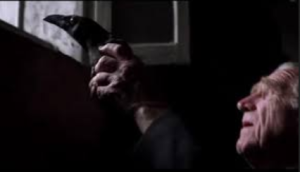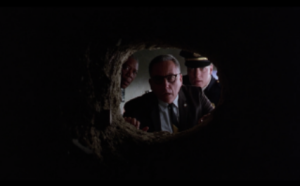14
“Examining Class in The Shawshank Redemption”
By Noel Lundeen
Linda Dufresne and Glenn Quentin are found together murdered in the fall of 1947. With a revolver in hand, the killer stops to reload, giving each victim an extra bullet. Tried and convicted for the murder of his wife and her lover, Andy Dufresne is sentenced to serve two life sentences in Shawshank State Prison. Following this series of events and for nearly twenty years, he finds his footing while encountering situations and individuals who undoubtedly shape his story. Through undertones of hardship, loyalty, oppression, and hope, The Shawshank Redemption also dispenses issues of social and class inequality in institutions of mass incarceration.
Much of the influence on the film can be accredited to the short story “Rita Hayworth and Shawshank Redemption” by Stephen King. Published in 1982, the novella came after significant events such as the New Mexico State Penitentiary Riot and the infamous prison on Alcatraz. Both situations involving incarcerated individuals whose related events are separated by several decades don’t fail to extricate the painful truths of the prison system. Phaedra Haywood describes in her piece on the 1980 penitentiary riot the neglectful issue of overcrowding. Relating to the New Mexico prison, she also notes that individuals much earlier “had complained for years about living conditions they said were substandard and violent…” (Haywood). Well-known stories and accounts of the Alcatraz Penitentiary are often glorified and dramatized. Numerous escape attempts have been documented over the years, but less widely known issues related to the prison deal with both prejudice and illegal practices within. Thought to have largely influenced King’s short story, issues related to Alcatraz and the New Mexico State Penitentiary are notable parallels to The Shawshank Redemption; drawing on its cynicism and criticism of the United State’s prison system.
After the court trial sequence in the film in which Andy receives two life sentences, he boards the bus en route to Shawshank Prison. Encoded by specific characters and themes, difference plays a critical role in shaping a crucial audience perspective. Shackled in single file, the newly introduced inmates shuffle past the gruff and intimidating prison guard known as Captain Byron Hadley who is responsible for a majority of brutal and violent acts in the film. Violent altercations between Andy and several inmates do take place during the beginning of his time in prison, but the majority of the violence within the film can be chalked up to authoritarian figures. Violence among inmates is an overused and incredibly common formula in prison films. In regards to the body of prisoners in The Shawshank Redemption, the Pop Culture Detective skillfully acknowledges, “Framing fictional prisoners as nothing but a bunch of vicious monsters helps to reinforce the widespread belief that prisoners in the real world deserve to be exploited, mistreated, or abused behind bars” (Pop Culture Detective). The difference between inmates of Shawshank and individuals in a majority of other prison films is a reduction of prisoner violence. In this way, the film seeks and succeeds to humanize its most important characters. Differences can also be acknowledged in the film in the adaptation the prisoners undergo in their transition to prison and how it greatly differs from the lives of “free” men. Within the film itself is a truth that several of the characters come to realize: After being behind bars for so long, it is what they come to know, and adapting to a “free” society you don’t live in is a difficult thing. A greatly influential character in the movie is Brooks Hatlen, the prison librarian. Set for release, he decides to free his pet crow Jake who has relied on the man from its infancy. Symbolic of his own experience once being set free from prison, an animal who has grown accustomed to living in captivity lacks the knowledge and ability to survive on its own.

Throughout the film, it is obvious where the power lies: with the white, straight, and able-bodied men in positions of authority. In Shawshank, these roles are filled specifically by the prison guards, as well as the parole board. As was mentioned previously, perpetrators of violence are almost always the prison guards who receive orders from Warden Norton. As he is shot from low angles along with the other prison staff, the audience becomes aware of his authority and the power imbalance that exists which is largely influenced by the aspects of mise en scène. Noted within America on Film, it is explained that, “a room with heavy shadows may seem threatening or scary… a camera shooting up from the floor at a character will create a different feeling than a camera aimed at eye-level” (Benshoff and Griffin 4). With respect to low shot camera angle, the first few scenes inside of the prison provide an accurate example (Myers). Crying and in obvious distress, a new inmate is shown crouching at the bars of his cell while the others audible commotion in the background. Drawn in by the obvious ruckus, Captain Byron Hadley marches to the distressed man’s cell, exuding obvious wicked energy. The man begs with him saying that he “isn’t supposed to be here.” Outwardly frustrated and menacing, Hadley exclaims, “I ain’t gonna count to three. I’m not even gonna count to one. You will shut the f – – – up or I’ll sing you a lullaby” (00:18:25). As the Captain is shot from a low angle, the audience is put in the perspective of the terrified man: powerless and with few choices of his own. Directly, discrimination is represented in The Shawshank Redemption.
Most of what can be seen in the film are both the belittlement and exploitation of men who are already facing incarceration. Indirectly and off-screen, an important portion of the narrative that deals with the subject of discrimination is thetime period decided on for the film adaptation by director Frank Darabont. It is explained that “Darabont has made the context 1947 specifically because of the widespread social and political discrimination to create a powerful backdrop for the film. The relationship between Andy and his Black inmate Red is enhanced creating a poignant engaging story” (“The Shawshank Redemption “). Issues that were not directly addressed on-screen are intertwined and evident nonetheless.
While it may be largely revered today, at the time of its release, The Shawshank Redemption was not entirely well-received. Over time it has earned cult status. The film was largely admonished by the Washington Post, saying that “Shawshank is a complete fairytale, a sentimental yarn filled with the darndest twists and turns… the inmates are – ultimately – a bunch of cute pushovers, and the worst thing about prison is the boredom” (Pop Culture Detective). To that, I would immediately counter that what they are referencing is the necessary humanization of these individuals. Incarceration in Hollywood blockbuster films is often steeped with hyper-masculinity and violence that isn’t displayed in this film. We see the inmates of Shawshank as people, for the film encourages the audience to ditch their preconceived notions and heavy cynicism in exchange for possible empathy and a new lens.

With a revolver in hand, the killer stops to reload, putting an extra bullet in each victim’s head. His name is Elmo Blatch. Innocent of the crime, Andy Dufresne is sentenced to life in prison for two murders he didn’t commit. His resilience, patience, and long-awaited justice are essential to the ultimate redemption. Encountering and examining issues of social inequality, The Shawshank Redemption leads us through an innocent man’s experience behind bars. More than that though, the film hinges on the deep profoundness of hope, and as Ellis Redding came to discover, “Hope is a good thing, maybe the best of things, and no good thing ever dies.”
References
Pop Culture Detective, director. How the Shawshank Redemption Humanizes Prisoners. Youtube, www.youtube.com/watch?v=rhGJ5SmSE2o&t=347s.
Ebert, R. (n.d.). The Shawshank Redemption movie review (1994): Roger Ebert. movie review (1994) | Roger Ebert. Retrieved February 20, 2022, https://www.rogerebert.com/reviews/great-movie-the-shawshank-redemption-1994
“The Shawshank Redemption.” Discovery, 28 Jan. 2016, eportfoliostudentno27869769.wordpress.com/2016/01/19/djdjjd/.
Monique Douty, 2021. “’The Shawshank Redemption’ Used Real-Life Ex-Cons as Extras and Fined Anyone Who Was Late to Filming.” Showbiz Cheat Sheet, 12 Sept. 2021, https://www.cheatsheet.com/entertainment/shawshank-redemption-used-real-life-ex-cons -extras-fined-anyone-late-filming.html/.
Myers, Scott. “Screenwriting & Editing: The Shawshank Redemption.” Medium: Go Into The Story, 27 Oct. 2016, https://gointothestory.blcklst.com/screenwriting-editing-the-shawshank-redemptio n-c6151a485ba4.

